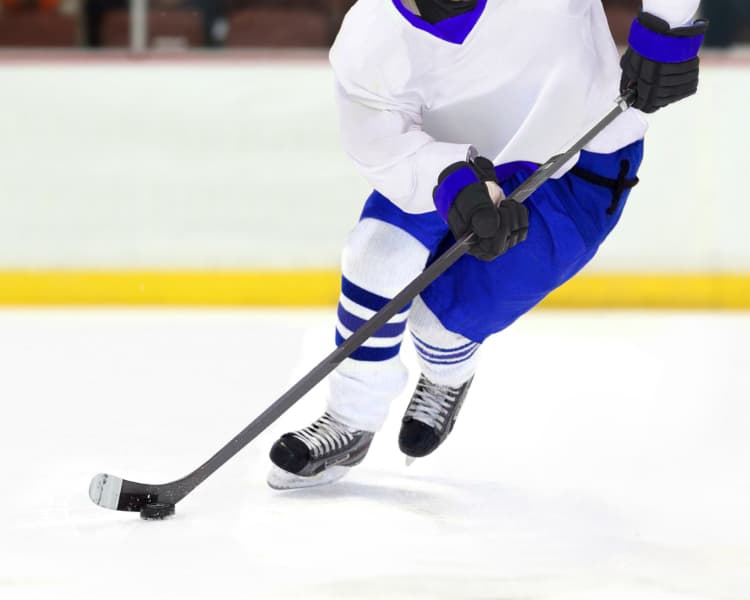What is Icing in Hockey?
Were you ever a puzzled parent like I once was, scratching your head and asking, “What is Icing in Hockey?!” It took me a whole decade, but I’ve got the lingo locked down now. In the simplest terms, Icing occurs when a player sends the puck from behind the center red line across the opposing team’s goal line, without it touching any other player or the goaltender. Stick around as we break down Icing and this rule’s history, intricacies, and impact in the game we all passionately love!
Demystifying the Icing Call: An Essential Guide to What is Icing in Hockey
Picture this: The crowd is roaring, and adrenaline is coursing through the veins of every player, parent, and spectator alike. The tension mounts as the puck whizzes through the frosty air, down the rink, and — bam — the whistle blows. It’s an Icing call, my friends! If you’re new to the fast-paced, edge-of-your-seat world of ice hockey, or even a seasoned Ice Hockey parent scratching their head in perplexity, you might be asking, “What is Icing in Hockey?
Well, let me assure you, it has nothing to do with the sugary stuff you slather on a cupcake. No siree!
Table of Contents
Icing is a rule or better yet an infraction that, once you understand it, can add layers of regret, strategy, and even some excitement to every game.
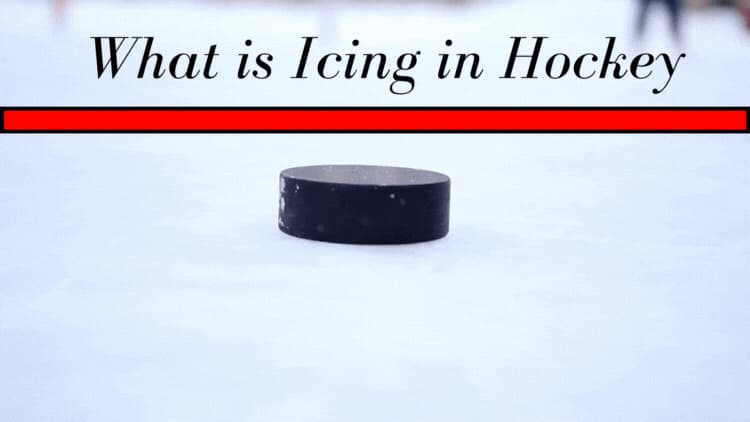
At its core, Icing happens when a player whizzes the puck from behind the center red line all the way past the opposing team’s goal line, without any other player or goalie getting a touch. If this happens, the linesman blows the whistle, the play is halted, and the puck returns to the offending team’s end for a face-off.
Now, there are different and sometimes confusing nuances and scenarios where icing is waved off by the ref, but that’s the crux of it. I’m going to clarify this icing rule more thoroughly, you’d swear the information was as smooth as ice fresh off a Zamboni pass.
You ask…why should you, as a hockey parent, understand Icing?
Because, knowledge is power, and a strong grasp of this rule lets you engage more deeply in the game, cheer on your young athlete with precision, and even help them strategize for success. In the riveting chess game that is Ice Hockey, Icing is like a pawn’s bold dash across the board—a move that can either put your team in a favorable position or put them on thin ice. Literally.
Understanding the ins and outs of Icing is your ticket to becoming not just an observer, but a true participant in the thrilling narrative of Ice Hockey.
The Icing Rule: A Basic Explanation
Decoding the Icing Rule: Real-World Examples
Imagine you’re huddled in the bleachers, eyes glued to your child. The game is in full swing, your child is in the defensive zone of the team, and the tension is palpable.
Suddenly, he whacks the puck in your defensive zone and from behind the center red line, sending it flying over the center line and past the red goal line at the opposite end of the ice. This specific action prompts the linesman to blow the whistle for what is termed an ‘Icing infraction.’
Because of this move:
- Play is stopped
- The puck is returned to your child’s team’s defensive zone for a face-off as an icing penalty.
- In essence, the game hits a pause button and reverts to a starting point that could potentially favor the defending team.
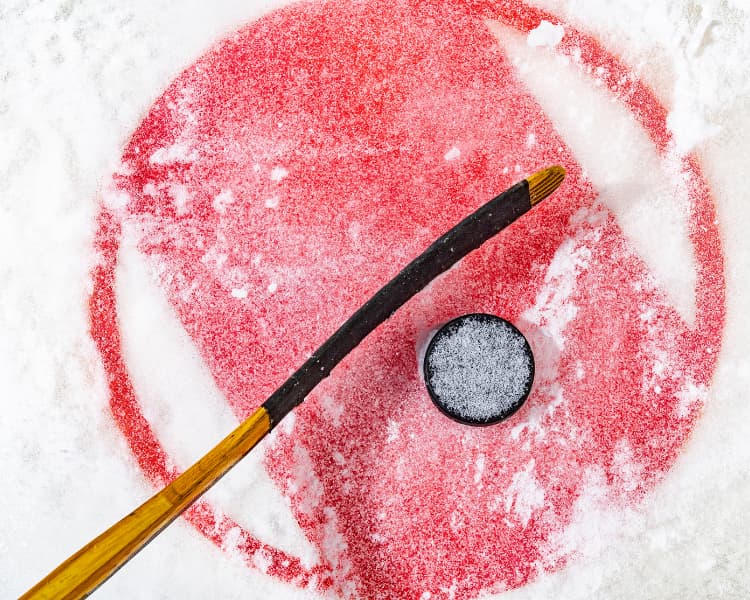
Understanding the specific jargon—such as ‘defensive zone,’ ‘offensive zone ‘center line,’ and ‘red goal line’—elevates your appreciation of the game and enables you to engage in more meaningful conversations with fellow parents and players alike.
I will break all this down in the pictures below:
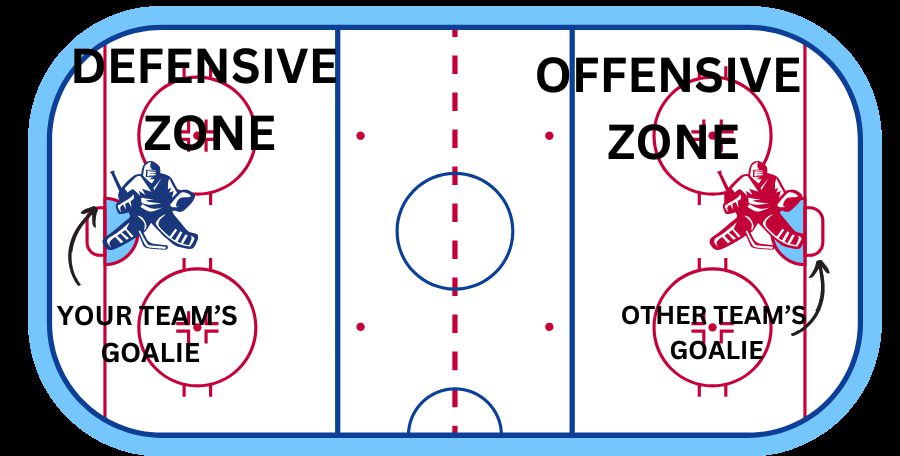
The History of the Icing Rule
The Genesis of the Icing Rule: A Trip Down Memory Lane
Believe it or not, the Icing rule wasn’t always a staple in Ice Hockey’s intricate tapestry of regulations. This rule found its roots in the early 20th century and was instituted for a very specific purpose—curbing the delaying tactic employed by players to kill time or relieve pressure.
Originally, the rule was straightforward: if the puck crosses from one side of the ice over the center line and then across the goal line of the opposing team without anyone touching it, it was deemed ‘Icing.’
The primary aim of instituting an Icing Rule was to maintain the flow of the game and discourage teams from simply flinging the puck down the rink when they found themselves in a defensive bind.
The History of Icing: Adapting to the Modern Game
Over the years, the Icing rule has undergone several revisions to adapt to the ever-changing landscape of Youth Hockey and the National Hockey League. The application of the rule varies slightly depending on the league, but its core remains consistent—eliminating it as a delaying tactic and promoting the flow of the game.
These tweaks and adaptations showcase the rule’s flexibility and its fundamental role in ensuring that the game remains exciting and fair for both players and fans alike.
Why Icing Matters: More Than Just a Whistle
In the fast-paced world of Ice Hockey, understanding the ins and outs of Icing is crucial for both seasoned veterans and newcomers to the sport.
When a player sends the puck down the rink and icing is called, a linesman halts the play. The game resumes with a faceoff in the zone of the team that caused the icing. If there’s a delayed penalty, the faceoff will take place in the attacking team’s neutral zone. In the event that the linesman made an incorrect icing call, the faceoff is then held at the central face-off spot, unless there is a pending delayed penalty to address.
Icing, beyond being just a whistle-blowing rule, plays a pivotal role in the game’s strategy. Players may intentionally commit icing to gain an advantage during a line change or relieve defensive pressure. This (sometimes last-ditch) tactical move allows the team to swap tired players with fresh players, potentially giving them an edge in the upcoming play.
On the flip side, Icing can also happen accidentally when a player clears the puck from their defensive zone to alleviate pressure but misses connecting with a teammate. Such an inadvertent move can result in a face-off on your own end, putting your team at a disadvantage.
Icing’s significance lies in its dual nature: it can be a tactical advantage or a pitfall.
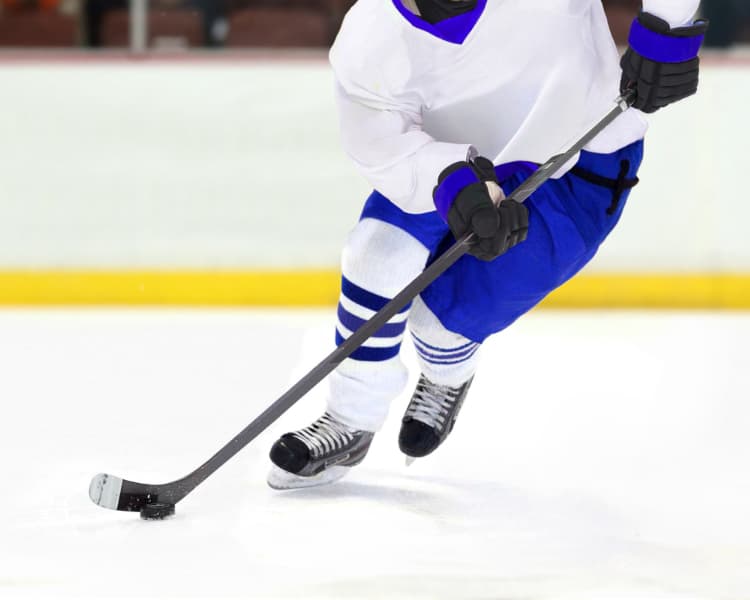
Also, Teams with one or two players in the penalty box are granted a unique advantage—they can ice the puck without any interference from the opposing team.
The tension in the arena was palpable as my son’s team capitalized on this power play opportunity. With a two-player advantage, they executed a flawless pass, sending the puck soaring from their half of the rink all the way to the opposing team’s side. It was a strategic move, an attempt to kill precious seconds off the clock while maintaining control of the game.
As a hockey parent, I couldn’t help but admire the precision and teamwork displayed on the ice. The opposing team, down two players, could do nothing but watch as the puck sailed past them, knowing they couldn’t touch it to stop the play. It was a rule that added a unique twist to the game.
The rule encourages players to make thoughtful decisions about when to clear the puck and when to maintain possession, teaching valuable strategic skills from a young age.
As Ice Hockey Parents, we witness firsthand how these rules influence the game, emphasizing the importance of both offensive and defensive strategies. So, next time you’re cheering from the side of the rink at your child’s game, remember that icing is not just a whistle but a crucial part of the game’s dynamics, teaching young athletes valuable lessons about decision-making and teamwork.
Icing Nuances: Exceptions and Variations
When Icing is “waved off” by Officials
When it comes to the touch Icing rule, there are some intriguing nuances that every Ice Hockey parent should be aware of. One of these nuances is when icing is “waved off” by officials. In certain situations, if the first player from the attacking team reaches the faceoff dots in the defending zone before the opposing player, icing can be waved off. This rule change was introduced to reward aggressive play and discourage teams from excessively relying on icing to clear the puck. It’s a determining factor that adds excitement to the game and keeps both players and fans engaged.
Common Misconceptions and Clarifications:
On the other hand, another crucial aspect of icing is the hybrid icing rule.
This rule, implemented to enhance player safety, involves a race to the faceoff dots, where the first player to reach them determines whether icing is called. It’s a blend of touch icing and automatic icing, aiming to reduce the risk of collisions near the boards.
Hybrid Icing
One such rule is Hybrid Icing, which introduces a unique twist to the classic race to the finish line. While the faceoff dots are typically considered the endpoint in a race between opposing players, the determining factor is not solely based on who reaches these dots first. Instead, it hinges on the linesman’s judgment of which player is likely to touch the puck first.
In cases where the race is too close to call by the time players reach the faceoff dots, icing is called. This rule change adds an element of anticipation and strategy to the game, making it imperative for players to gauge their speed and positioning carefully.
For example, certain leagues introduced the “Hybrid Icing,” where the linesman has the discretion to wave off the icing call if a player of the team that committed the infraction appears likely to reach the puck first.
Touch Icing
Touch Icing, another facet of the icing rules, maintains the intensity of play. The puck remains in play until a player from the defending team (excluding the goaltender) successfully touches it after it has been shot into their own zone and crosses behind the goal line.
If the puck is shot down the ice and the first contact is made by a player from the team that initially shot it, the play continues without an icing call. This rule emphasizes the importance of defensive players’ engagement in the game and ensures that the play is not halted prematurely.
No Touch Icing
Conversely, No Touch Icing, also known as automatic icing, streamlines the process. When the puck crosses the goal line after being shot into the zone from the other side of the center ice red line, the play is automatically whistled dead and called icing.
This rule eliminates the need for physical contact to determine icing and prioritizes player safety by preventing unnecessary collisions along the boards. Understanding these different icing variations is vital for young players and their supportive parents, as it adds layers of strategy and excitement to the ice hockey experience.
The Role of the Parent: Taking Icing in Stride
Let’s face it, being a hockey parent means you’re often as invested in the game as your young athlete is. But when that whistle blows for an icing call, don’t jump out of your thermal socks just yet!
Icing is a rule that’s as much about strategy as it is about regulation.
Let’s take this real life example below:
The tension in the arena was palpable as my son’s team capitalized on this power play opportunity. With a two-player advantage, they executed a flawless pass, sending the puck soaring from their half of the rink all the way to the opposing team’s side. It was a strategic move, an attempt to kill precious seconds off the clock while maintaining control of the game.
As a hockey parent, I couldn’t help but admire the precision and teamwork displayed on the ice. The opposing team, down two players, could do nothing but watch as the puck sailed past them, knowing they couldn’t touch it to stop the play. It was a rule that added a unique twist to the game.
So, instead of viewing an icing call as a foul or a mistake, consider it a tactical decision—one that young players will get the hang of over time. Infuse a sense of playfulness into these moments; maybe create a little sideline ritual for every icing call to make it fun and educational at the same time.
Being a supportive hockey parent means more than cheering from the bleachers; it includes grasping the ins and outs of the game. As you deepen your own understanding of rules like icing, you’re not just broadening your hockey IQ—you’re also creating richer opportunities for bonding and dialogue with your child.
Next time you’re driving home from practice or enjoying a post-game cocoa, use your knowledge of icing to spark a conversation about on-ice strategy and teamwork. It’ll be a win-win, enriching both your experience as a parent, the growth of your player, and your relationship overall.

